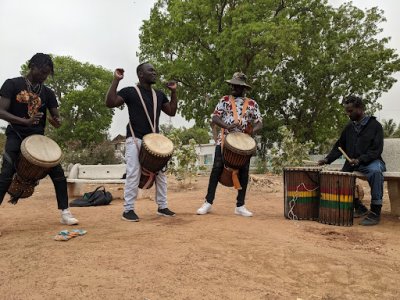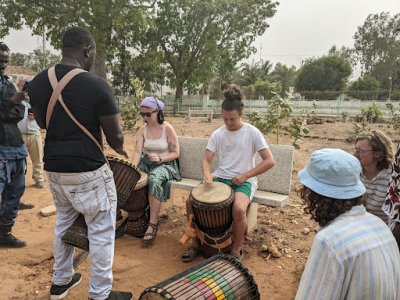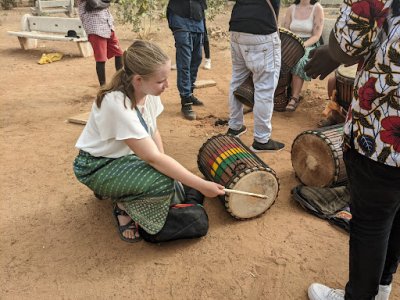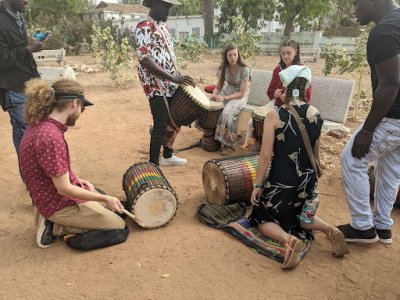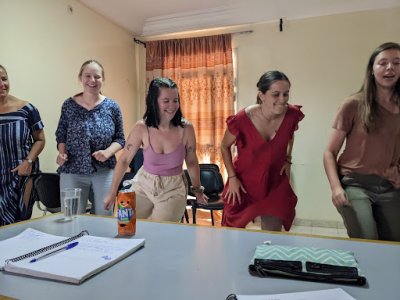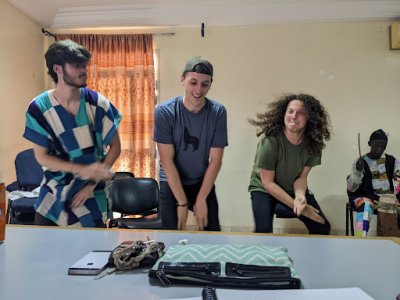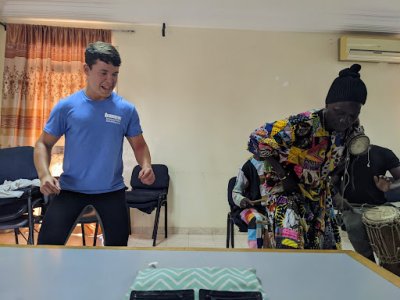Griots, Drums, and Dancing
In this post Emma B. and Gabe reflect on our week of music and the arts in Senegal. On Monday, June 6, our group met up with a griot and his drumming group. Griots were part of the traditional caste structure of many West African cultures. They play the role of storytellers, musicians, praise singers and oral historians in their communities. Modern griots like Youssou Ndour have carried on that tradition in modern times.
Drumming Lessons
We were all looking forward to the music lesson since the moment we were told about it. The day had finally come! We piled into taxis, and headed to the designated meeting spot across town. When we got there, the meeting spot had changed and we got directions to a new location. The directions helped but we didn’t need them. Instead, we followed the rhythmic, upbeat pounding of the drums echoing from a distance. Our excitement grew with each step closer to the drumming. Eventually, we arrived at a beautiful public park where four drummers welcomed us with a lively demonstration of their craft!
As the show came to an end, the lead drummer gave us a brief introduction to the rhythmic patterns on the djembe. The actual musical rhythms we learned are hard to explain since they are not in the same counting styles we know (4 beats per measure). The best way to explain it is that everything that is played is essentially polyrhythmic beats. Polyrhythmic beats are two or more beats that do not follow each other. For most, this is a skill that is extremely hard to master, but the drummers play it like it was second nature. That is what years and years of practice can do!
Hands on Learning
Following the brief lesson, they put us into groups, giving us turns on the djembes so we could practice the Senegalese drumming patterns. Each of us learned a different part. As we individually learned our parts, we saw how it was coming together, which made us even more excited! Before we knew it, we were all jamming out. Some would say it was like a scene straight out of Drumline the movie.
As the jam session alternated with different people, the same enthusiastic, lively energy flowed through us all. We followed the beating of the drums with clapping, dancing, and faces filled with joy. Sports and music bring communities together and that was shown instantly by one of our own! Birch Baer has been a drummer for years. As his turn came, he showed his skills. The drummers were impressed with the movements of his hands on the djembe. His hands flowed with grace but hit with the same energy and intensity as our teachers. He even improvised, impressing the teachers even more!
As the drumming lessons came to end, the drummers put on another amazing show. Seeing their faces as they played their djembes was truly amazing. Not only could you hear their passion for the music, but you could see it. Music is a way of life for them. Learning from such skilled musicians was truly an honor.
Dancing Lessons
The day after our drumming lessons, the group met in our usual classroom at John Huffman to learn about griots, drums, and dancing. The griot greeted our class with a round of drumming before introducing himself and his helpers. They showed us the various drums and the different sounds each one makes while we clapped along enthusiastically. After finishing their performance, or “spectacle” as they call it, the lead drummer offered to show the group how to dance the three traditional Senegalese dances. Bree Wheeler and Suzanna Yoder fearlessly stepped up to the plate, or rather up to the front. The class shouted encouraging words as they prepared to show their moves.
The first dance involved moving the hips to the right, and then the left, and finally towards the back all to the beat of the drums. For every loud lump, the hips went in a new direction. As a spectator, it was quite amusing to watch! A new round of dancers headed up front to learn the second, slightly more complicated dance. This involved a host of claps along with one leg hops, an interesting knee spreading move, and you guessed it, all to the beat of the drums. In small groups, all of us courageously marched to the front of the classroom to try out the new moves, often performing quite well for a bunch of toubabs. Even Kendra and David got up and showed off their moves!
Talking drums and ancient traditions
After the dancing concluded, they invited Birch to learn how to play the tama, or talking drum. This drum fits right under the armpit and the player uses pressure from the bicep to change the sound of the drum. Griots traditionally make the tama drum using the wood of the tamarind tree. The drum has two goat leather drum heads and cotton and nylon thread is used on the exterior of the wooden body. They also use the tamarind tree to make the curved drumstick. Heat from a cooking fire is used to curve the end of the wood into the striking end of the drumstick. After a few adjustments, Birch was playing like a pro!
Before ending our meeting, the musicians explained how music has flowed in their blood for generations. Their ancestors were griots just as they are now. Although anyone can learn music and become a musician, griots will always have secrets they cannot share with their students.
